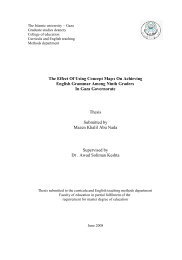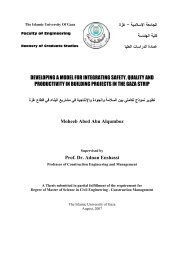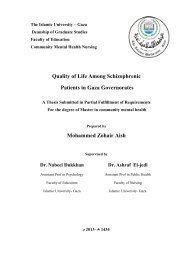A Study of Lean Construction Practices in Gaza Strip
A Study of Lean Construction Practices in Gaza Strip
A Study of Lean Construction Practices in Gaza Strip
You also want an ePaper? Increase the reach of your titles
YUMPU automatically turns print PDFs into web optimized ePapers that Google loves.
7. Poor technology <strong>of</strong> equipment.<br />
8. Shortage <strong>of</strong> tools and equipments required.<br />
10. Rework due to workers’ mistakes.<br />
11. Damage to work done caused by subsequent trades.<br />
12. Poor workmanship.<br />
2.8.3 Inventory<br />
Inventory waste means hav<strong>in</strong>g unnecessarily high levels <strong>of</strong> raw materials, work-<strong>in</strong>progress<br />
and f<strong>in</strong>ished products. Extra <strong>in</strong>ventory leads to higher <strong>in</strong>ventory f<strong>in</strong>anc<strong>in</strong>g<br />
costs, higher storage costs and higher defect rates.<br />
Inventory hides waste and defects as materials that have been fabricated and stored for<br />
various projects, backlog <strong>of</strong> good work over jobs, a batch <strong>of</strong> eng<strong>in</strong>eer<strong>in</strong>g<br />
recommendations, and massive amounts <strong>of</strong> data be<strong>in</strong>g stored for use at a later date or<br />
never used at all.<br />
Inventory waste <strong>of</strong> construction <strong>in</strong> the <strong>Gaza</strong> <strong>Strip</strong> is due to:<br />
1. Wrong storage <strong>of</strong> materials.<br />
2. Inadequate stack<strong>in</strong>g and <strong>in</strong>sufficient storage on site.<br />
3. Insufficient <strong>in</strong>structions about storage and stack<strong>in</strong>g.<br />
4. Inappropriate storage lead<strong>in</strong>g to damage or deterioration.<br />
2.8.4 Transportation: (Material Movement)<br />
Transportation <strong>in</strong>cludes any movement <strong>of</strong> materials that does not add any value to the<br />
product, such as mov<strong>in</strong>g materials between workstations. The idea is that transportation<br />
<strong>of</strong> materials between productions stages should aim for the ideal that the output <strong>of</strong> one<br />
process is immediately used as the <strong>in</strong>put for the next process. Transportation between<br />
process<strong>in</strong>g stages results <strong>in</strong> prolong<strong>in</strong>g production cycle times, the <strong>in</strong>efficient use <strong>of</strong><br />
labor and space and can also be a source <strong>of</strong> m<strong>in</strong>or production stoppages. Unnecessarily<br />
mov<strong>in</strong>g materials wastes<br />
time, energy, resources, and <strong>in</strong>creases the likelihood <strong>of</strong> <strong>in</strong>jury such as mov<strong>in</strong>g work-<strong>in</strong>process<br />
from a site to site, mov<strong>in</strong>g an eng<strong>in</strong>eer<strong>in</strong>g recommendation from one area to<br />
another for review, mov<strong>in</strong>g pipe from location to location.<br />
Transportation waste <strong>of</strong> construction <strong>in</strong> the <strong>Gaza</strong> <strong>Strip</strong> is due to:<br />
1. Damage dur<strong>in</strong>g transportation<br />
2. Use <strong>of</strong> <strong>in</strong>adequate tools and equipments<br />
26

















